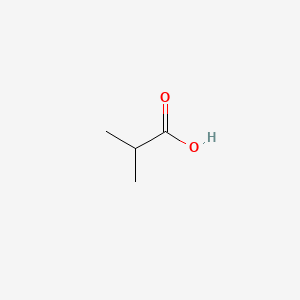| MeSH term | MeSH ID | Detail |
|---|---|---|
| Myoclonic Epilepsies, Progressive | D020191 | 3 associated lipids |
| Werner Syndrome | D014898 | 4 associated lipids |
| Malabsorption Syndromes | D008286 | 16 associated lipids |
| Gastrointestinal Hemorrhage | D006471 | 27 associated lipids |
| Hyperlipidemias | D006949 | 73 associated lipids |
| Stomach Ulcer | D013276 | 75 associated lipids |
| Carcinoma, Hepatocellular | D006528 | 140 associated lipids |
| Colonic Neoplasms | D003110 | 161 associated lipids |
| Adenocarcinoma | D000230 | 166 associated lipids |
| Body Weight | D001835 | 333 associated lipids |
ISOBUTYRIC ACID
ISOBUTYRIC ACID is a lipid of Fatty Acyls (FA) class. Isobutyric acid is associated with abnormalities such as Atrophy, Muscular, Spinobulbar. The involved functions are known as Signal Transduction, Oxidation, Vmax, Metabolic Inhibition and Regulation. Isobutyric acid often locates in Cytoplasm, Plasma membrane, peroxisome, Mouse Embryonic Fibroblast and Protoplasm. The associated genes with ISOBUTYRIC ACID are Candidate Disease Gene, CDKN1A gene, MYC gene, E2F1 gene and HBP1 gene. The related lipids are butyrate, Butyrates, lipid structure, Fatty Acids and Propionate. The related experimental models are Knock-out.
Cross Reference
Introduction
To understand associated biological information of ISOBUTYRIC ACID, we collected biological information of abnormalities, associated pathways, cellular/molecular locations, biological functions, related genes/proteins, lipids and common seen animal/experimental models with organized paragraphs from literatures.
What diseases are associated with ISOBUTYRIC ACID?
ISOBUTYRIC ACID is suspected in Atrophy, Muscular, Spinobulbar and other diseases in descending order of the highest number of associated sentences.
Related references are mostly published in these journals:
| Disease | Cross reference | Weighted score | Related literature |
|---|
Possible diseases from mapped MeSH terms on references
We collected disease MeSH terms mapped to the references associated with ISOBUTYRIC ACID
PubChem Associated disorders and diseases
What pathways are associated with ISOBUTYRIC ACID
There are no associated biomedical information in the current reference collection.
PubChem Biomolecular Interactions and Pathways
Link to PubChem Biomolecular Interactions and PathwaysWhat cellular locations are associated with ISOBUTYRIC ACID?
Visualization in cellular structure
Associated locations are in red color. Not associated locations are in black.
Related references are published most in these journals:
| Location | Cross reference | Weighted score | Related literatures |
|---|
What functions are associated with ISOBUTYRIC ACID?
Related references are published most in these journals:
| Function | Cross reference | Weighted score | Related literatures |
|---|
What lipids are associated with ISOBUTYRIC ACID?
Related references are published most in these journals:
| Lipid concept | Cross reference | Weighted score | Related literatures |
|---|
What genes are associated with ISOBUTYRIC ACID?
Related references are published most in these journals:
| Gene | Cross reference | Weighted score | Related literatures |
|---|
What common seen animal models are associated with ISOBUTYRIC ACID?
Knock-out
Knock-out are used in the study 'G1/S arrest induced by histone deacetylase inhibitor sodium butyrate in E1A + Ras-transformed cells is mediated through down-regulation of E2F activity and stabilization of beta-catenin.' (Abramova MV et al., 2006).
Related references are published most in these journals:
| Model | Cross reference | Weighted score | Related literatures |
|---|
NCBI Entrez Crosslinks
All references with ISOBUTYRIC ACID
Download all related citations| Authors | Title | Published | Journal | PubMed Link |
|---|---|---|---|---|
| Suzuki-Mizushima Y et al. | Enhancement of NGF- and cholera toxin-induced neurite outgrowth by butyrate in PC12 cells. | 2002 | Brain Res. | pmid:12270499 |
| Hornung DE et al. | Olfactory mucosa/air partitioning of odorants. | 1987 | Brain Res. | pmid:3496142 |
| Laakel M et al. | Relationship between valine, fatty acids, and spiramycin biosynthesis in Streptomyces ambofaciens. | 1994 | Can. J. Microbiol. | pmid:7922889 |
| Lounès A et al. | Regulation of valine catabolism by ammonium in Streptomyces ambofaciens, producer of spiramycin. | 1995 | Can. J. Microbiol. | pmid:7585357 |
| Mercier J and Jiménez JI | Potential of the volatile-producing fungus Muscodor albus for control of building molds. | 2007 | Can. J. Microbiol. | pmid:17538650 |
| Pine L et al. | Physiological studies on the growth and utilization of sugars by Listeria species. | 1989 | Can. J. Microbiol. | pmid:2501014 |
| Sun JL et al. | Metabolic profiling of Staphylococcus aureus cultivated under aerobic and anaerobic conditions with (1)H NMR-based nontargeted analysis. | 2012 | Can. J. Microbiol. | pmid:22571732 |
| Hanai Y et al. | Analysis of volatile organic compounds released from human lung cancer cells and from the urine of tumor-bearing mice. | 2012 | Cancer Cell Int. | pmid:22364569 |
| Huang H et al. | Carboxypeptidase A3 (CPA3): a novel gene highly induced by histone deacetylase inhibitors during differentiation of prostate epithelial cancer cells. | 1999 | Cancer Res. | pmid:10383164 |
| Kambara T and Tomioka K | Controlling factors in chiral bisoxazoline-catalyzed asymmetric lithium ester enolate-imine condensation producing a beta-lactam. | 2000 | Chem. Pharm. Bull. | pmid:11045472 |
